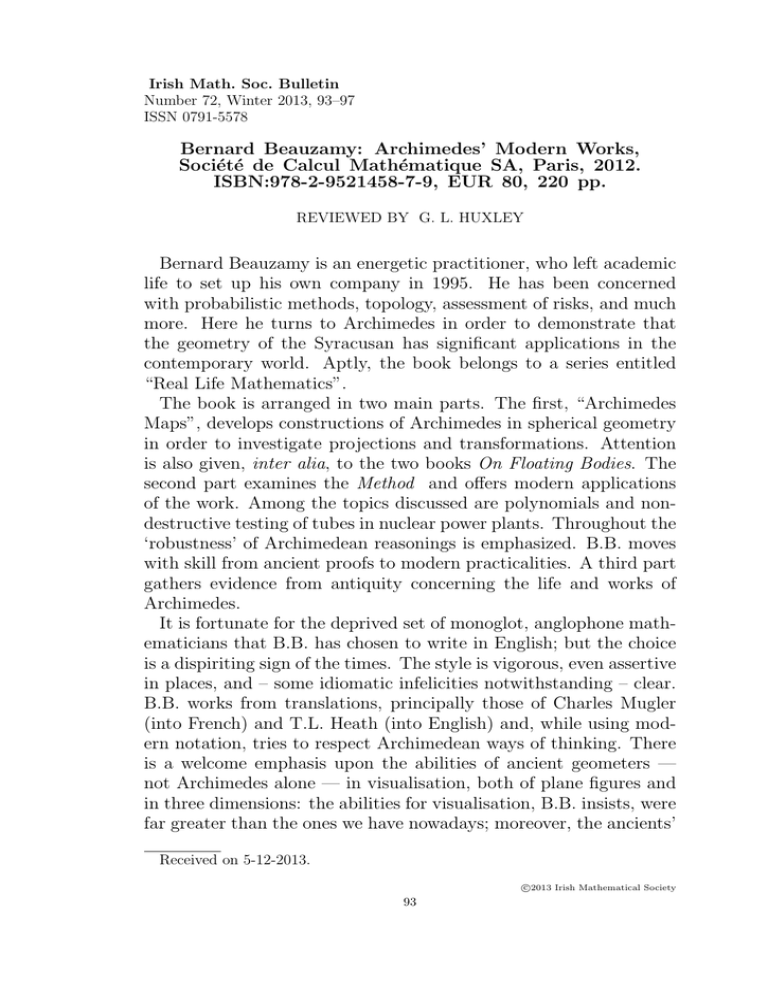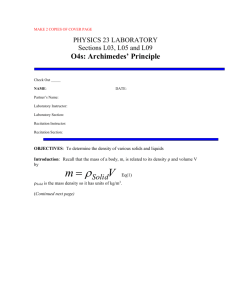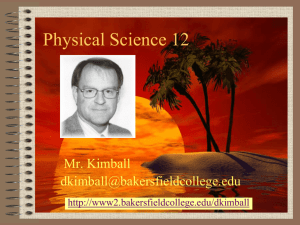Bernard Beauzamy: Archimedes’ Modern Works, Soci´ et´ e de Calcul Math´
advertisement

Irish Math. Soc. Bulletin Number 72, Winter 2013, 93–97 ISSN 0791-5578 Bernard Beauzamy: Archimedes’ Modern Works, Société de Calcul Mathématique SA, Paris, 2012. ISBN:978-2-9521458-7-9, EUR 80, 220 pp. REVIEWED BY G. L. HUXLEY Bernard Beauzamy is an energetic practitioner, who left academic life to set up his own company in 1995. He has been concerned with probabilistic methods, topology, assessment of risks, and much more. Here he turns to Archimedes in order to demonstrate that the geometry of the Syracusan has significant applications in the contemporary world. Aptly, the book belongs to a series entitled “Real Life Mathematics”. The book is arranged in two main parts. The first, “Archimedes Maps”, develops constructions of Archimedes in spherical geometry in order to investigate projections and transformations. Attention is also given, inter alia, to the two books On Floating Bodies. The second part examines the Method and offers modern applications of the work. Among the topics discussed are polynomials and nondestructive testing of tubes in nuclear power plants. Throughout the ‘robustness’ of Archimedean reasonings is emphasized. B.B. moves with skill from ancient proofs to modern practicalities. A third part gathers evidence from antiquity concerning the life and works of Archimedes. It is fortunate for the deprived set of monoglot, anglophone mathematicians that B.B. has chosen to write in English; but the choice is a dispiriting sign of the times. The style is vigorous, even assertive in places, and – some idiomatic infelicities notwithstanding – clear. B.B. works from translations, principally those of Charles Mugler (into French) and T.L. Heath (into English) and, while using modern notation, tries to respect Archimedean ways of thinking. There is a welcome emphasis upon the abilities of ancient geometers — not Archimedes alone — in visualisation, both of plane figures and in three dimensions: the abilities for visualisation, B.B. insists, were far greater than the ones we have nowadays; moreover, the ancients’ Received on 5-12-2013. c 2013 Irish Mathematical Society 93 94 G. L. HUXLEY memories were better than ours. “Every machine we invent comes to the detriment of our faculties” (p.211). (I recall the complaint of a distinguished engineer that many of his pupils could not think threedimensionally when presented with plane drawings of machines and structures: my response was to recommend a course in ancient solid geometry.) As a palliative to weakness in visualisation, B.B. suggests that a useful task would be to put all Archimedean texts into modern mathematical notation (p.47); they could then be compared with existing theories, as he attempts with spheres and the Method in this book. But the pedagogical difficulties would be great, both for teachers and taught. “Besides”, he adds astringently, “nowadays in everyday life people want formulas, they do not want to think”. Archimedean principles could, he proposes, be taught in “special research places”. Comments upon some matters of detail will demonstrate the originality and reach of the book. P.12. The notion of Archimedes sending ‘preprints’ to colleagues is attractive; but that he sometimes sent completed proofs is clear, for example, from the greetings to Dositheus at the beginning of On the Sphere and Cylinder, Book I. P.12. Not only was the way of thinking of Archimedes “extremely different from ours”; so also was the way of Apollonius and hence also of Newton in the conics of the Principia. Compare Richard Feynman’s remark: “. . . although the methods of Newton were geometrical, he was writing in a time in which the knowledge of the conic sections was the thing that everybody knew very well, and so he perpetually uses (for me) completely obscure properties of the conic sections. . . ” (D.L. and J.R. Goodstein, Feynman’s Lost Lecture (London 1997) 152). P.15. The criticism of the mathematical competence of translators seems somewhat harsh. Even B.B. would, I trust, think well of the work of E.J. Dijksterhuis, Archimedes (Copenhagen 1956): it is not in the bibliography on p.216. P22. The Archimedean notion of convexity is admired and praised. Note that in the Greek the words convex (kyrtos) and concave (koilos) are coupled with epi ta auta, ‘in the same direction’. T.L. Heath in the introduction to his Archimedes has a most helpful chapter (VIII) on the terminology of Archimedes. P.44. ‘Not much happened in mathematics between 212BC and 1544 AC . . . ’ This is too sweeping a generalisation. We do not enhance the merits of Archimedes by ignoring his successors Greek, Arabic, Indian. P.45. In the mention of BEAUZAMY 95 the measurement of the earth by Eratosthenes the figure of 50km in the base line is baffling. His estimated base line extended southwards from Alexandria to Syene. P.46. B.B. suggests that Newton may not have read Archimedes; moreover he thinks that Newton (and Leibniz) may have ignored Archimedes, deeming him to have been ‘too ancient’. But Newton, whose respect for antiquity was great, does not ignore ancients in the Principia: a notable use of ancient geometry is the solution of the problem Locus ad quattuor lineas ‘begun by Euclid and continued by Apollonius’; Newton insists that the solution is not found by the calculus but by geometrical composition, as the ancients required (Book I, Section V, Lemma XIX). It is known that Newton studied Archimedes carefully: he went over Barrow’s work on Archimedes in order to find corrections for the list of errata (see Richard S. Westfall, Never at Rest (Cambridge 1980) 258). In Principia Book I, Proposition 71 Newton contemplates two spheres mutually attracting one another as if their masses were concentrated at their centres. We are close here to Archimedean notions of centres of gravity. Pp.49-53. The demonstration of the Archimedean character of the Lambert projection in representing the earth’s hemisphere is thoroughly praiseworthy. Geographers, too, can study ancient synthetic geometry with benefit. The advantages over Mercator’s projection are manifest in F. Guiénard’s map (p.53). P.56. In the illuminating discussion of optimal location of resources (employing Archimedean maps) the problem of where to put ten stations for monitoring water quality on a river is said to be a one dimensional problem. But is it not a three dimensional problem unless the river is a straight line (as is most unlikely in nature)? P.65. The assertion that we like co-ordinates more than we should raises vital questions in the philosophy of mathematics and the teaching thereof. Is B.B. advocating greater emphasis upon pre-Cartesian geometry or even a return to Euclid and Apollonius? P.83. “For a modern reader the Method will look very strange”. Perhaps: but if strange, at once recognisably powerful. Let us recall a remark of Littlewood quoted by G.H. Hardy in A Mathematician’s Apology (1967 reprint, p.81): ‘. . . they are not clever schoolboys or ‘scholarship candidates’, but Fellows of another college’. B.B. would welcome Hardy’s further comment: ‘Archimedes will be remembered when Aeschylus is forgotten, because languages die and mathematical ideas do not’. P.85. Eudoxus of Cnidus is not quoted in Euclid, 96 G. L. HUXLEY Elements Book XII, Proposition 10. P.90, bottom. Again, a welcome setting-off of geometrical comparison, giving insight, against “our modern manipulation of formulas”. Pp.91-93. Historicallyminded readers, too, will be happy that B.B. has supplied the lost Archimedean proof of the centre of gravity of a cone of revolution. For suggestions as to where Archimedes may have given the proof see Heath, Method of Archimedes p.15 note. P. 107. The reviewer may be pathetically behind the times, but would anybody now seriously claim that “nobody, in the twenty-first century, cares about centres of gravity any more” (These are, by the way, not rarely, good times to be behind). P.109, middle. “One is led. . . ”, not “lead”, and definitely not Pb; here, it seems, is a characteristic failure of spell-check. Pp.116-120. Historians will welcome the demonstration showing how Archimedes tested the composition of Hieron’s crown (the report of Vitruvius, correctly treated as historical by B.B., is given on pp. 198-199). P.148. There is a fine instance of B.B.’s skill in lateral thinking in the analogy from optical refraction to the dynamical problem of an object moving between two points on either side of a boundary with differing velocities on either side, in least time. P.205. The remarks about archaeologists are insulting in the letter; it is not surprising that no reply came from Syracuse. However, B.B.’s wish to find the place of the tomb of Archimedes is commendable. Pp.208-210. Mathematically and technically equipped readers will be able to follow with amusement the fictional Roman siege and Sicilian defence of Syracuse in 2010. Pp.213-214. B.B. does not expound the work of Archimedes On Spirals, though rotations are used on pp.120-123. It would be interesting, for example, to learn what more he would have to say about revolutions of a straight line about one extremity in the definitions preceding Proposition 12 of On Spirals. There are a few oddities. For instance, B.B. states: “Archimedes wrote in the Doric dialect, which, apparently, was rather close to Ancient Greek” (p.14). But Doric was a dialect of Ancient Greek. Again, the statement (pp.46-47) that mathematical notation did not exist at the time is puzzling; B.B. adds that Archimedes writes full sentences. But the Greek alphabetical numerals are a notation, and Archimedes makes excellent use of them for example in the Measurement of a Circle. It is not clear what B.B. means by ‘notation’ here. BEAUZAMY 97 The book exhibits versatility, ingenuity, and insight. It is also enterprising: Electricité de France, for example, may well have gained benefits from the mathematical advice of B.B. and his colleagues. Readers are left in no doubt that there is a place for ancient Greek geometrical thought in the modern world; it is to be hoped that B.B.’s advocacy of Archimedean doctrines will bring intellectual blessings. G. L. Huxley is a former Vice-President of the Royal Irish Academy, Dublin. He is an Honorary Professor of Greek in Trinity College, Dublin and an Adjunct Professor in the Departments of Mathematics and of Ancient Classics at the National University of Ireland, Maynooth. He is a Member of Academia Europaea. Department of Mathematics and Statistics, NUI, Maynooth, Co. Kildare, Ireland E-mail address: admin@maths.nuim.ie


